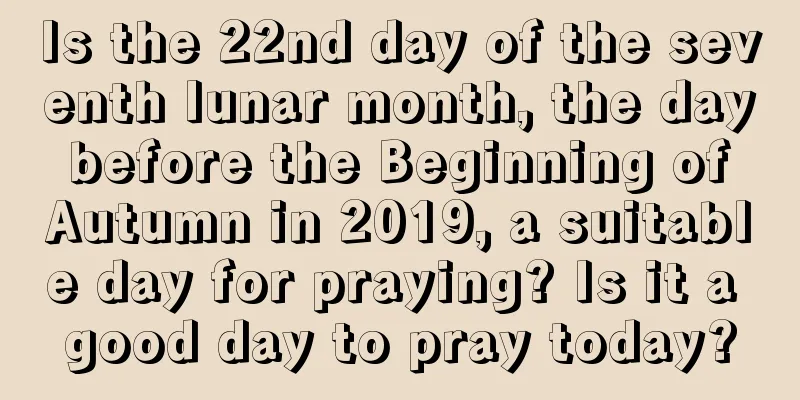When is Laba Festival in 2018? The Origin of Laba Festival

The origin of Laba Festival has a lot to do with Buddhism. So when is Laba Festival in 2018? What is the origin of Laba Festival? The twelfth month of the lunar calendar is commonly known as La Yue. Come to Shui Mo Xiansheng's website to learn about the relevant content of the twelfth month of the lunar calendar in 2018!When is Laba Festival in 2018?December 8, 2018 (Lunar calendar)January 13, 2019, Sunday, Capricorn (solar calendar) 【Today’s lunar calendar is suitable】 Pray for blessings, get married, move, bring in wealth, move into a new home, install a bed and make a stove, accept marriage proposals, build houses, fast and offer sacrifices, take up a post, seek offspring, erect pillars, raise beams, plant crops, bring in livestock, catch animals, and go to school. [Today’s taboos in the almanac] Repair graves, bury, open warehouses, start drilling, travel, meridians, break ground What is the origin of Laba Festival?1. Laba Festival is the eighth day of the twelfth lunar month. It originated in the late Yuan Dynasty and early Ming Dynasty. It is said that when Zhu Yuanzhang was imprisoned and suffering, it was a cold day. Zhu Yuanzhang, who was cold and hungry, actually dug out some red beans, rice, red dates and seven or eight kinds of grains from the rat hole in the prison. Zhu Yuanzhang cooked these things into porridge. Because that day was the eighth day of the twelfth lunar month, Zhu Yuanzhang named this pot of multi-grain porridge "Laba porridge". Enjoyed a delicious meal. Later, Zhu Yuanzhang pacified the world and became the emperor. In order to commemorate that special day in prison, he designated that day as Laba Festival and officially named the multi-grain porridge he ate that day as Laba porridge.2. The founder of Buddhism, Sakyamuni, was originally the son of King Suddhodana of Kapilavastu in northern ancient India (in present-day Nepal). Seeing that all living beings were suffering from birth, old age, sickness and death, and being dissatisfied with the theocratic rule of the Brahmins at the time, he gave up the throne and became a monk. He achieved nothing at first, but after six years of asceticism, on the eighth day of the twelfth lunar month, he attained enlightenment under the Bodhi tree and became a Buddha. During these six years of asceticism, he only ate one grain of hemp and one grain of rice every day. Later generations did not forget the suffering he endured, and ate porridge on the eighth day of the twelfth lunar month every year to commemorate him. "Laba" became the "Buddha's Enlightenment Day". "Laba" is a grand festival in Buddhism. Before liberation, Buddhist temples across the country held Buddha bathing ceremonies and chanting sessions, and imitated the legend of the shepherdess offering gruel to Sakyamuni before he attained enlightenment. They cooked porridge with fragrant grains and fruits to offer to the Buddha, which was called "Laba porridge." Laba porridge was given to disciples and believers, and it later became a folk custom. It is said that before the eighth day of the twelfth lunar month, monks in some temples would hold bowls and beg for alms on the streets. They would cook the collected rice, chestnuts, dates, nuts and other ingredients into Laba porridge and distribute it to the poor. It is said that after eating it one can get the blessing of Buddha, so the poor call it "Buddha porridge". The evolution history of Laba porridge:In the Qing Dynasty, in the third year of Yongzheng's reign (1725 AD), Emperor Shizong converted the mansion east of the Imperial College inside Andingmen in Beijing into the Lama Temple. On the eighth day of the twelfth lunar month, Laba porridge was cooked in Wanfu Pavilion and other places in the palace, and Lama monks were invited to chant scriptures. The porridge was then distributed to the ministers of the royal palace, who tasted and ate it to celebrate the festival. The "Guangxu Shuntian Prefecture Chronicle" also said: "On the eighth day of the twelfth lunar month every year, the Yonghe officials cook porridge according to custom, and send ministers to supervise it, and it is served as a meal." Laba porridge is also called "Seven Treasures Porridge" and "Five Flavors Porridge". The earliest Laba porridge was made with red beans. Later, it evolved and became more colorful with the addition of local characteristics. Zhou Mi, a scholar in the Southern Song Dynasty, wrote in "Wulin Jiushi": "The porridge made with walnuts, pine nuts, milk mulberry, persimmon, chestnut and the like is called Laba porridge." Fu Cha Dunchong, a Qing Dynasty writer, said in "Yanjing Sui Shi Ji" that "Laba porridge is made with yellow rice, white rice, glutinous rice, millet, water chestnut rice, chestnut, peeled date paste, etc., boiled with water, and dyed with red peach kernels, almonds, melon seeds, peanuts, hazelnuts, pine nuts, white sugar, brown sugar, and grapes for coloring", which is quite characteristic of the Beijing city. |
<<: What constellation is the twelfth lunar month of 2018? Is fate good or bad?
Recommend
When is the Chinese Valentine's Day in 2018? What are the customs of the Chinese Valentine's Day?
Introduction: China has been a traditional country...
How to spend Chinese Valentine's Day alone in 2019?
It is said that the older you get, the lonelier yo...
What constellation and zodiac sign do people born in August of the lunar calendar in 2020 belong to?
Each month has a corresponding constellation and z...
Can I move on September 10, 2019, Teacher's Day? About the evolution of the Teacher's Day date!
Introduction: Moving is an important matter, so yo...
Is the twelfth day of the fourth lunar month in 2020 a good day? April 12th lunar month
Is the twelfth day of the fourth lunar month in 2...
What is the fate of a girl born on the first day of the fifth lunar month in 2022? What is missing from the five elements?
The fifth month of the lunar calendar is the secon...
When will the baby be born if you are pregnant on Mother's Day in 2020?
Every day, a lot of people get pregnant, and natur...
Is it possible to sign the contract on the sixth day of the first lunar month in 2018? What should I pay attention to when signing the contract?
Chinese people attach great importance to agreemen...
Is it a good idea to open a business on the second day of the third lunar month in 2018?
Chinese people believe in fate and value tradition...
What are the customs of Qingming Festival? What are some poems that describe Qingming Festival?
Qingming Festival is not just a solar term, it is ...
What are the do's and don'ts on December 22, 2018 in the lunar calendar?
Some days are auspicious, while others are inausp...
Where is the auspicious position of the God of Wealth on the 17th day of the second lunar month in 2017?
Introduction: Our country is a typical traditional...
Is July 14th of the lunar calendar 2021 an auspicious day for a funeral? How is life?
Funeral is also an important matter, so an auspici...
The direction of the God of Happiness on the 14th day of the fifth lunar month in 2018
The fifth month of the lunar calendar is consider...
Can I sign a contract on the twelfth day of the twelfth lunar month in 2021? Is it good to sign the contract?
If you want to sign the contract smoothly, you als...









